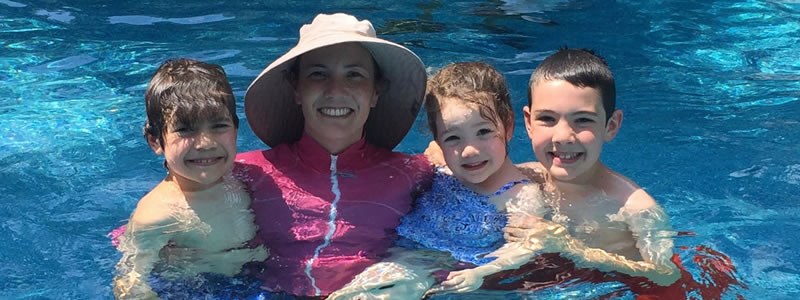
|
|
|
|
|
|
|
|

All children manipulate those in control. You as a parent are on duty 24 hours a day and there are gaps in your continuity of parenting. Since I have them for 10 minutes at a time, I pay no attention to the manipulative noise (crying). Saving one's life demands an immediate action, which is developed as a conditioned response.
| Look happy (even though you may be uneasy). Your feelings are transferred to your child. If you appear to be happy, the child will acclimate to the activity. When parenting eye contact is essential! So do not wear sunglasses! |
Valuable Suggestions After the Swim Lessons
Use the same drills as we used during lessons. The side and steps can be your partner. If two adults are available, have the child swim between the two. Extend the distance in either of the above situations as the ability increases. Give lots of encouragement and smiles. Do not extend the swimming distance your child swims by moving backwards. If you want an 8 foot swim, stand 8 feet from their starting position. This will maintain your creditability with your child.
• Use a calm, reassuring voice in all aspects.
• Use lots of encouragement.
• Promote slow swimming.
A comment, which is consistent with all aspects of my philosophy of water instruction is do not ask... tell. If there is something you want your child to do, do not give them a choice. For example, if you have to go to the grocery store, politely say "It's time to go to the grocery store." If you say, "Do you want to go to the grocery store?" and the child replies, "no," you are givng them the control when you know what needs to happen. Be in charge of all areas of the child rearing that necessitates mature and responsible decisions; of course swimming is just one of many. Another parenting tool to consider, since the new skill of swimming has been successful, is to use it with future new educational experiences. Remember, success promotes other successes.
Use of Arms
The use of arms to aid a young (under 3 1/2 years) swimmer is minimal at best. The child's legs are what provide the forward movement. Since the swimmer is on his/her feet, the muscles are more developed at this stage. The arms become a factor as a general rule at about 3 1/2 years of age. The first arm movement is termed a "dog paddle." The next in the progression of learning is the breaststroke (circles with the arms). A crawl or "big arm stroke" is the logical next step. Most swimmers will reach with their arms making the body similar to a surfboard or horizontal position. This position is the best way to save a life.
Breathing
Do not push a new swimmer to get a breath. The breathing position is more or less vertical and the child is not a water treader due to the lack of body strength and the horizontal swimming position is what saves a life. As the new swimmer gets more strength and confidence, breathing will take care of itself.
Pool Safety
Make the new swimmer aware of the difference of each swimming venue. The sides of the pool that are unreachable. Location of boards, steps and ladders. Use and misuse of slides and diving. The variables that help determine a "safe" pool for your child are threefold:
• Height of pool water.
• Distance from the top of the water to top of the deck.
• Length of the child's arm.
A child who cannot reach the side is not safe no matter how good a swimmer.
When to Help and How
Needless to say, help when necessary, but calmly — don't panic and be reassuring at all times. Furthermore, often children, when first swimming with a parent will, when directed to swim to the side steps, make a U-turn back to the adult. In spite of the desire to pick (or rescue) up the swimmer, redirect the child back to the original destination. This is done by using your hand on the back of their head while still under water until they have reached the safety of the steps or side. They will not remember your redirection, but they would remember the rescue.
In an accident (child falls into pool under no supervision), the most important factor is the immediate reaction must be survival, not waiting for a rescue by Mom or Dad; that would just result in a tragic ending.
Transitions From a Pool to Other Water Conditions
(Ocean, Lakes and Rivers)
• Walk child in knee-deep water to get used to the irregularity of the bottom.
• Two adults standing at a chest level depth and have the swimmer go back and forth a distance of 6-8 feet.
• First adult walks child out to a depth where they cannot touch and then swim to second adult for 6-8 feet.
• Second adult turns child around and has the swimmer go in to a point where they can find the bottom and stand by themselves.
You should not make comments about the water conditions; they will adapt.
Copyright © 2024 Swim Safe, LLC. All rights reserved.
 |
|
|